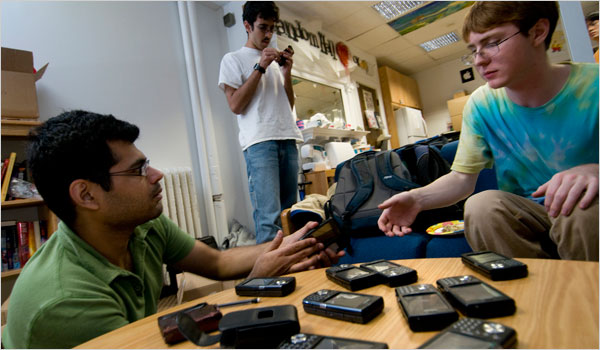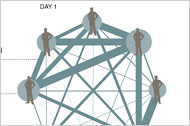Cambridge, Mass.
Multimedia
HARRISON BROWN, an 18-year-old freshman majoring in mathematics at M.I.T., didn’t need to do complex calculations to figure out he liked this deal: in exchange for letting researchers track his every move, he receives a free smartphone.
Now, when he dials another student, researchers know. When he sends an e-mail or text message, they also know. When he listens to music, they know the song. Every moment he has his Windows Mobile smartphone with him, they know where he is, and who’s nearby.
Mr. Brown and about 100 other students living in Random Hall at M.I.T. have agreed to swap their privacy for smartphones that generate digital trails to be beamed to a central computer. Beyond individual actions, the devices capture a moving picture of the dorm’s social network.
The students’ data is but a bubble in a vast sea of digital information being recorded by an ever thicker web of sensors, from phones to GPS units to the tags in office ID badges, that capture our movements and interactions. Coupled with information already gathered from sources like Web surfing and credit cards, the data is the basis for an emerging field called collective intelligence.
Propelled by new technologies and the Internet’s steady incursion into every nook and cranny of life, collective intelligence offers powerful capabilities, from improving the efficiency of advertising to giving community groups new ways to organize.
But even its practitioners acknowledge that, if misused, collective intelligence tools could create an Orwellian future on a level Big Brother could only dream of.
Collective intelligence could make it possible for insurance companies, for example, to use behavioral data to covertly identify people suffering from a particular disease and deny them insurance coverage. Similarly, the government or law enforcement agencies could identify members of a protest group by tracking social networks revealed by the new technology. “There are so many uses for this technology — from marketing to war fighting — that I can’t imagine it not pervading our lives in just the next few years,” says Steve Steinberg, a computer scientist who works for an investment firm in New York.
In a widely read Web posting, he argued that there were significant chances that it would be misused, “This is one of the most significant technology trends I have seen in years; it may also be one of the most pernicious.”
For the last 50 years, Americans have worried about the privacy of the individual in the computer age. But new technologies have become so powerful that protecting individual privacy may no longer be the only issue. Now, with the Internet, wireless sensors, and the capability to analyze an avalanche of data, a person’s profile can be drawn without monitoring him or her directly.
“Some have argued that with new technology there is a diminished expectation of privacy,” said Marc Rotenberg, executive director of the Electronic Privacy Information Center, a privacy rights group in Washington. “But the opposite may also be true. New techniques may require us to expand our understanding of privacy and to address the impact that data collection has on groups of individuals and not simply a single person.”
Mr. Brown, for one, isn’t concerned about losing his privacy. The M.I.T researchers have convinced him that they have gone to great lengths to protect any information generated by the experiment that would reveal his identity.
Besides, he says, “the way I see it, we all have Facebook pages, we all have e-mail and Web sites and blogs.”
“This is a drop in the bucket in terms of privacy,” he adds.
GOOGLE and its vast farm of more than a million search engine servers spread around the globe remain the best example of the power and wealth-building potential of collective intelligence. Google’s fabled PageRank algorithm, which was originally responsible for the quality of Google’s search results, drew its precision from the inherent wisdom in the billions of individual Web links that people create.















